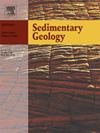伊朗北部Alborz山脉寒武纪生物礁复合体和pelmatozoi -rhynchonelliformean草甸:苗岭-芙龙期后生生物礁缺乏范式的再评价
IF 2.9
2区 地球科学
Q1 GEOLOGY
引用次数: 0
摘要
伊朗北部的Alborz山脉是世界范围内苗岭-佛隆纪(寒武纪)碳酸盐丰度和珊瑚礁体积下降的少数例外之一,可能与冈瓦纳东北部到达亚热带纬度有关。冈瓦纳边缘记录了微生物和壳壳碳酸盐工厂的逐步成核,岩石地层学上被认为是拉伦组和米拉组的成员。晚寒武世二世至妙岭期,在公海和保护(后障)环境中,显示出蛇状-类状堆积和微生物堆积的发育,具有层状和凝块结构。相比之下,苗岭晚期和芙蓉期记录了广泛建立的pelmatozoa -rhynchonelliformean草甸,局部受地堑地形的影响。悬壁块体对高能量的浅水条件提供了一定的保护,这有利于花青体-微生物礁群的生长。pelmatozoa -rhynchonelliformean壳层中记录的原生孔隙度,以及与之相关的骨壁微钻孔和泥晶化作用,有利于碳酸盐岩和氧化铁硬岩的幕式发育。这种奇异性导致了一个更全面的全球模式的发展,该模式与庙令纪-芙蓉纪87Sr/86Sr比值的逐渐下降、碳酸盐台地和珊瑚礁体积的估计范围以及大气O2(与SPICE事件相关的急剧增加)以及海水方解石饱和度的相对增加有关。在一些亚热带地区,如冈瓦纳的奥尔布尔士边缘,后生动物造架者的再次出现发生在苗岭晚期,它们随后的造礁成功主要受构造活动和高孔隙的贝壳层硬底成核的控制。本文章由计算机程序翻译,如有差异,请以英文原文为准。
Cambrian reef complexes and pelmatozoan-rhynchonelliformean meadows from the Alborz Mountains, northern Iran: A reassessment of the Miaolingian–Furongian paucity of metazoan reefs paradigm
The Alborz Mountains in northern Iran represent one of the few exceptions to the worldwide decline in Miaolingian–Furongian (Cambrian) carbonate abundance and reefal volume, likely related to the arrival of northeastern Gondwana to subtropical latitudes. This Gondwana margin recorded the stepwise nucleation of microbial and shelly carbonate factories, lithostratigraphically recognized as members of the Lalun and Mila formations. The late Cambrian Epoch 2 to Miaolingian interval displays the development of oncoid-pisoid accumulations and microbial build-ups, with laminated and clotted textures, in open-sea and protected (back-barrier) settings. In contrast, the late Miaolingian and Furongian interval recorded a generalized establishment of pelmatozoan-rhynchonelliformean meadows, locally affected by horst-and-graben topographies. Hanging-wall blocks offered some protection from high-energy, shallow-water conditions, which favoured the growth of anthaspidellid-microbial reef complexes. The primary porosity recorded in the pelmatozoan-rhynchonelliformean shell beds, and the associated microboring and micritization of skeletal walls, favoured the episodic development of carbonate and iron oxyhydroxide hardgrounds. Such a singularity leads to the development of a more comprehensive global model linked to Miaolingian–Furongian progressive declines in 87Sr/86Sr ratios, estimated extent of carbonate platforms and reefal volume and atmospheric O2 (punctuated by a sharp increase related to the SPICE event), coeval with relative increases in seawater calcite saturation. In some subtropical areas, such as in the Alborz margin of Gondwana, the re-occurrence of metazoan frame-builders took place in late Miaolingian times, and their subsequent reefal success was primarily controlled by tectonic activity and the nucleation of hardgrounds in highly porous pelmatozoan-rhynchonelliformean shell beds.
求助全文
通过发布文献求助,成功后即可免费获取论文全文。
去求助
来源期刊

Sedimentary Geology
地学-地质学
CiteScore
5.10
自引率
7.10%
发文量
133
审稿时长
32 days
期刊介绍:
Sedimentary Geology is a journal that rapidly publishes high quality, original research and review papers that cover all aspects of sediments and sedimentary rocks at all spatial and temporal scales. Submitted papers must make a significant contribution to the field of study and must place the research in a broad context, so that it is of interest to the diverse, international readership of the journal. Papers that are largely descriptive in nature, of limited scope or local geographical significance, or based on limited data will not be considered for publication.
 求助内容:
求助内容: 应助结果提醒方式:
应助结果提醒方式:


